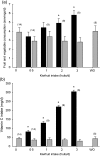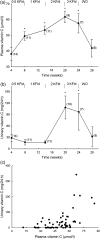Bioavailability of vitamin C from kiwifruit in non-smoking males: determination of 'healthy' and 'optimal' intakes
- PMID: 25191543
- PMCID: PMC4153093
- DOI: 10.1017/jns.2012.15
Bioavailability of vitamin C from kiwifruit in non-smoking males: determination of 'healthy' and 'optimal' intakes
Abstract
Vitamin C is an essential nutrient in humans and must be obtained through the diet. The aim of this study was to determine vitamin C uptake in healthy volunteers after consuming kiwifruit (Actinidia chinensis var. Hort. 16A), and to determine the amount of fruit required to raise plasma vitamin C to 'healthy' (i.e. >50 µmol/l) and 'optimal' or saturating levels (i.e. >70 µmol/l). Leucocyte and urinary vitamin C levels were also determined. A total of fifteen male university students with below average levels of plasma vitamin C were selected for the study. Weekly fasting blood samples were obtained for a 4-week lead-in period and following supplementation with, sequentially, half, one, two and three Gold kiwifruit per d for 4-6 weeks each, followed by a final 4-week washout period. The results showed that addition of as little as half a kiwifruit per d resulted in a significant increase in plasma vitamin C. However, one kiwifruit per d was required to reach what is considered healthy levels. Increasing the dose of kiwifruit to two per d resulted in further increases in plasma vitamin C levels as well as increased urinary output of the vitamin, indicating that plasma levels were saturating at this dosage. Dividing the participants into high and low vitamin C groups based on their baseline plasma and leucocyte vitamin C levels demonstrated that it is critical to obtain a study population with low initial levels of the vitamin in order to ascertain a consistent effect of supplementation.
Keywords: DTPA, diethylene triamine pentaacetic acid; Human saturation levels; Kiwifruit supplementation; Leucocytes; Plasma vitamin C; RDI, recommended dietary intake.
Figures


 ), total minus kiwifruit intervention.
Data are means, with standard errors represented by vertical bars. The numbers of
participants are indicated in parentheses. * Mean value was significantly different
from that at baseline (P < 0·05; one-way repeated-measures
ANOVA with the Fisher least significant deviation pairwise multiple comparison
procedure). WO, washout.
), total minus kiwifruit intervention.
Data are means, with standard errors represented by vertical bars. The numbers of
participants are indicated in parentheses. * Mean value was significantly different
from that at baseline (P < 0·05; one-way repeated-measures
ANOVA with the Fisher least significant deviation pairwise multiple comparison
procedure). WO, washout.


Similar articles
-
A randomized steady-state bioavailability study of synthetic versus natural (kiwifruit-derived) vitamin C.Nutrients. 2013 Sep 17;5(9):3684-95. doi: 10.3390/nu5093684. Nutrients. 2013. PMID: 24067392 Free PMC article. Clinical Trial.
-
A randomised cross-over pharmacokinetic bioavailability study of synthetic versus kiwifruit-derived vitamin C.Nutrients. 2013 Nov 11;5(11):4451-61. doi: 10.3390/nu5114451. Nutrients. 2013. PMID: 24284610 Free PMC article. Clinical Trial.
-
SunGold Kiwifruit Supplementation of Individuals with Prediabetes Alters Gut Microbiota and Improves Vitamin C Status, Anthropometric and Clinical Markers.Nutrients. 2018 Jul 12;10(7):895. doi: 10.3390/nu10070895. Nutrients. 2018. PMID: 30002355 Free PMC article. Clinical Trial.
-
The bioavailability of vitamin C from kiwifruit.Adv Food Nutr Res. 2013;68:125-47. doi: 10.1016/B978-0-12-394294-4.00007-9. Adv Food Nutr Res. 2013. PMID: 23394985 Review.
-
Kiwifruit: our daily prescription for health.Can J Physiol Pharmacol. 2013 Jun;91(6):442-7. doi: 10.1139/cjpp-2012-0303. Epub 2013 May 15. Can J Physiol Pharmacol. 2013. PMID: 23746068 Review.
Cited by
-
Behind the Skin: A Rare Case of Scurvy-Associated Megaloblastic Anemia.Clin Med Insights Case Rep. 2019 May 10;12:1179547619849036. doi: 10.1177/1179547619849036. eCollection 2019. Clin Med Insights Case Rep. 2019. PMID: 31205433 Free PMC article.
-
The nutritional and health attributes of kiwifruit: a review.Eur J Nutr. 2018 Dec;57(8):2659-2676. doi: 10.1007/s00394-018-1627-z. Epub 2018 Feb 22. Eur J Nutr. 2018. PMID: 29470689 Free PMC article. Review.
-
Experimental folate deficiency in human subjects: what is the influence of vitamin C status on time taken to develop megaloblastic anaemia?BMC Hematol. 2018 Jun 19;18:13. doi: 10.1186/s12878-018-0107-2. eCollection 2018. BMC Hematol. 2018. PMID: 29946471 Free PMC article.
-
Patients with Community Acquired Pneumonia Exhibit Depleted Vitamin C Status and Elevated Oxidative Stress.Nutrients. 2020 May 6;12(5):1318. doi: 10.3390/nu12051318. Nutrients. 2020. PMID: 32384616 Free PMC article.
-
SunGold Kiwifruit Consumption Restores Adequate to Optimal Vitamin C Status in People with a History of Severe Respiratory Infections.Antioxidants (Basel). 2024 Feb 23;13(3):272. doi: 10.3390/antiox13030272. Antioxidants (Basel). 2024. PMID: 38539806 Free PMC article.
References
-
- Burri BJ & Jacob RA (1997) Human metabolism and the requirement for vitamin C In Vitamin C in Health and Disease, pp. 341–366 [Packer L and Fuchs J, editors]. New York: Marcel Dekker
-
- Sauberlich HE (1997) A history of scurvy and vitamin C In Vitamin C in Health and Disease, pp. 1–24 [Packer L and Fuchs J, editors]. New York: Marcel Dekker
-
- Tsao CS (1997) An overview of ascorbic acid chemistry and biochemistry In Vitamin C in Health and Disease, pp. 25–58 [Packer L and Fuchs J, editors]. New York: Marcel Dekker
-
- Carr A & Frei B (1999) Does vitamin C act as a pro-oxidant under physiological conditions? FASEB J 13, 1007–1024 - PubMed
-
- Loenarz C & Schofield CJ (2008) Expanding chemical biology of 2-oxoglutarate oxygenases. Nat Chem Biol 4, 152–156 - PubMed
LinkOut - more resources
Full Text Sources

